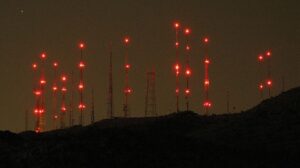
My first commercial radio job was the Saturday 7pm-Midnight shift at WRCN/Riverhead, a station on the east end of Long Island that played what we called in those days Album Oriented Rock. That’s where I began learning how to be a broadcaster. I wrote about the interview that got me that job here.
I had already done college radio for a few years, but this was different. I had almost no say in what songs I played, which was fine with me because I was more concerned with what went into the microphone than what came out of the turntable. WRCN’s nighttime audience consisted mostly of people in their teens and twenties, and while they also listened to the station’s morning man/program director, Don Brink, he appealed to people in their thirties and forties, too.
That’s because, like many personalities who were on the air during the breakfast shift, he was more of a Morning Mayor — smooth voice, easy to listen to, able to talk about the music as well as read news updates and keep things flowing for people on their way to work. His playlist consisted of artists like Fleetwood Mac, Cheap Trick, and Tom Petty. But after dark, when I was on the air, it was more Led Zeppelin, AC/DC, and Pink Floyd.
I once asked Don how much commercials cost during my show. He explained that no sponsors were specifically buying ads in that time slot, but rather used what were called Run Of Schedule campaigns, which aired in all dayparts throughout the week. During the summer, when WRCN’s audience grew tremendously thanks to an extra million people vacationing in The Hamptons, spots cost more. But in the middle of the winter, he said, they probably went for a buck apiece, a rate that applied to the overnight show, too.
In that era, it was not unusual for TV and radio stations to end their broadcast days by signing off at midnight, 1am, or 2am, then come back on at 6am. So my next question for Don was why WRCN stayed on the air all night considering how little money it made during those hours. He explained that no matter when listeners went to sleep, he wanted them to have WRCN be the last thing they heard — so when they woke up in the morning, his was the first voice they heard.
So, many rock and top forty stations hired men with big personalities and women with mellifluous voices to fill the evening slots. Those DJs knew they were targeting a different audience than their daytime colleagues and connected with them in different ways. They’d play an entire album all the way through or do special themed sets or just be as funny or weird as possible. Picture Wolfman Jack in “American Graffiti.”
Today, none of that exists. People under 30 don’t even own radios, let alone listen to one, because they get all the music they want from Spotify, YouTube, and TikTok. You can have a chicken-or-egg debate, but part of the blame for that demographic pivoting from broadcast radio at night is because the corporations that own the stations don’t even try anymore. Lamenting this trend, radio industry consultant Fred Jacobs recently wrote:
Some have elected to voicetrack those hours, usually “hosted” by an out-of-town voice, an internal production person, the PD, or maybe even someone from a station across the hall. In most cases, the shows sound pedestrian and undynamic. Sadly, little in the way of resources or effort goes into making these hours sound competitive. And because they’re pre-recorded, there’s almost always no interactivity between the station and whoever’s out there listening – no phones, no social media.
Other stations do even less, electing to segue songs, dropping repetitive production, positioners, and IDs in between. More and more listeners “get” what’s going on when a radio station is in “autopilot” during night, overnights, and oftentimes, throughout the weekends. When radio puts so little into these large expanses of time, why should an audience react with anything more than boredom and ambivalence?
When I moved to WHCN/Hartford in the early eighties, Laurie Gypson held down the fort from midnight till dawn. She understood the work-at-night-sleep-during-the-day world, so she hosted the very clever Third Shifters Lunchtime Request Hour from 3am to 4am — and answered every call from listeners.
Tonight there won’t even be a human being at the station to notice the phones ringing.
